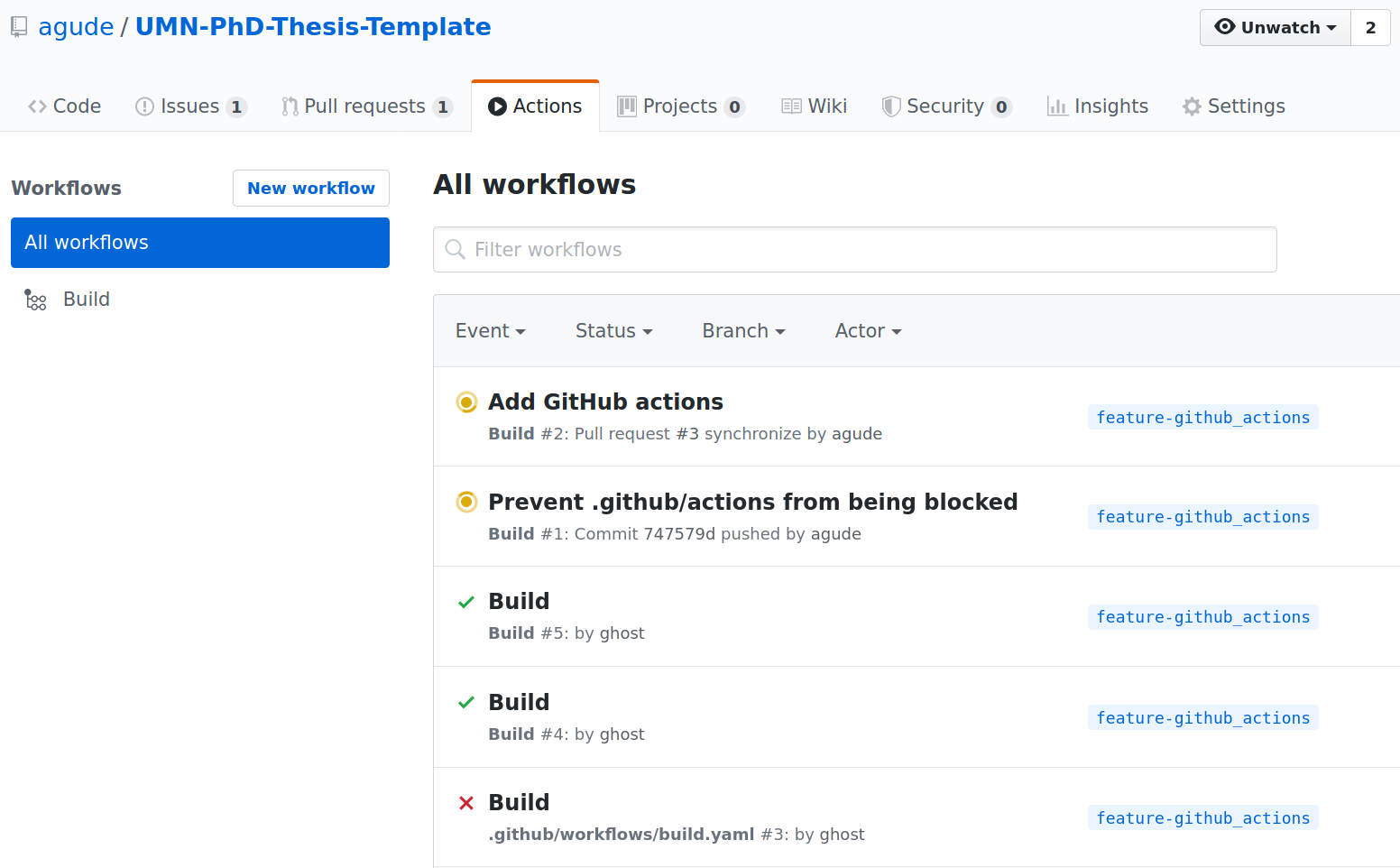This repository contains an updated version of the UMN PhD Thesis Template.
To build the thesis locally, on Ubuntu 18.04, you will need to install:
# Install the required packages
sudo apt-get install \
texlive-latex-base \
texlive-latex-extra \
texlive-fonts-recommended \
texlive-pictures \
texlive-science \You can then build the thesis with make:
makeThis will produce a thesis.pdf in the root directory of your repository,
along with all the intermediate build files. You can instead run:
make tidyTo just produce the PDF.
The easiest way to build the PDF is to use Github Actions. This will build the thesis and produce a PDF all within Github. The repository already contains the correct configuration files, but you will need to enable actions in Github.
Once this is done, you can click on the "Actions" tab at the top of the repository on Github.
There you'll see a list of build jobs. The ones with green check marks have completed successfully. Clicking on one will bring you to the build page, where there will be a section titled Artifacts. Click on "Compiled Thesis" to download a zip file containing the PDF.
The thesis template comes with some useful additional packages. They are described below.
cleveref is a package designed
to make cross referencing easier. Unlike \ref, \cref automatically adds
the prefix required for the object being referenced. For example,
\cref{fig:my_fig} will produce text like "figure 1" whereas
\ref{fig:my_fig} would simply produce "1" and require you to fill in the
"figure".
Additionally, cleveref can handle multiple references at once.
\cref{fig:my_fig,fig:my_fig2} produces "figures 1 and 2".
In the main thesis file, the following is set:
\newcommand{\creflastconjunction}{, and } % Always use the serial commaThis includes the serial comma in lists, so that
\cref{fig:my_fig,fig:my_fig2,fig_other_fig} produces "figures 1, 2, and 3"
instead of "figures 1, 2 and 3".
Additionally, the package is passed the option noabbrev which causes it to
print the full prefix instead of an abbreviation ("figure" vs "fig.").
SIunitx formats SI units. It
provides the \SI{} command, which is used as follows:
\SI{3.8}{\tesla}
\SI{14}{\kilo\tonne}
\SI{14.6}{\meter\squared}
\SI{8}{\tera\eV}There are various abbreviations for units (such as \SI{8}{\TeV}) and the
formatting of the numbers can be controlled in detail. Additionally, it
provides \SIrange{1}{5}{\meter} which produces "1m to 5m" and
\SIlist{1;2;3}{\kelvin} which produces "1K, 2K, and 3K".
The package also provides \num{12345} which will format numbers (just like
\SI) but without adding units. The previous example produces "12,345" for
instance.
In the main thesis file, the following default options are set:
% Configure the siunitx package
\sisetup{
group-separator = {,}, % Use , to separate groups of digits, like 12,345
list-final-separator = {, and } % Always use the serial comma in \SIlist
}group-separator makes the package separate groups of digits with commas (so
12,345.0), and list-final-separator uses the serial comma in lists ("1K, 2K,
and 3K", not "1K, 2K and 3K").
The way in which units are displayed can also be redefined, as has been done
\electronvolt in the macros file:
% Define a better looking eV by moving the V slightly left
\DeclareSIUnit\electronvolt{e\hspace{-0.08em}V}booktabs adds options to make
nicer tables. It defines \toprule, \midrule, and \bottomrule which add
rules of varying thickness and with additional vertical space.
An example table using these commands is shown below. The @{} removes extra
space on the end of the tables (so that the rules start and end flush with the
text instead of hanging over) and the \spacerows{1.2} command is defined in
the macros file and adds extra space between the rows.
\begin{table}[h]
\centering
\spacerows{1.2}
\begin{center}
\begin{tabular}{@{}l r@{}}
\toprule
Mode & Fraction $\left( \Gamma_{i} / \Gamma \right)$ \\
\midrule
$\Ztoqq$ & $69.91 \pm 0.06\%$ \\
$\Ztoee$ & $3.363 \pm 0.004\%$ \\
$\Ztomumu$ & $3.366 \pm 0.007\%$ \\
$\Ztotautau$ & $3.370 \pm 0.008\%$ \\
$\Ztonunu$ & $20.00 \pm 0.06\%$ \\
\bottomrule
\end{tabular}
\caption{
Selected decay modes of the Z boson.
}
\label{table:z_decays}
\end{center}
\end{table}
